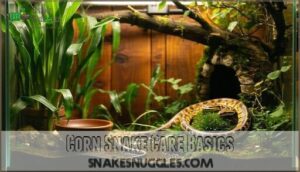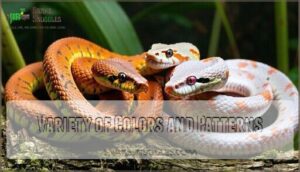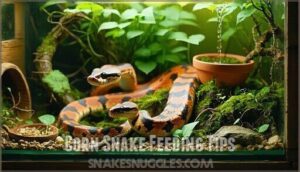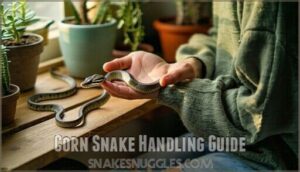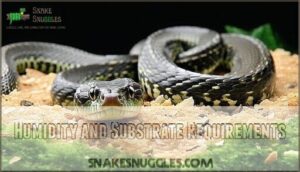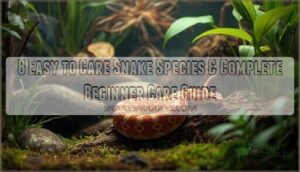This site is supported by our readers. We may earn a commission, at no cost to you, if you purchase through links.
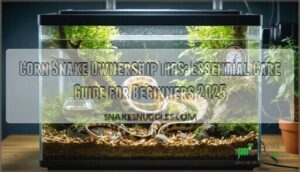 You’ll need a 40-gallon terrarium with a secure lid, maintaining temperatures between 75-85°F and 40-60% humidity for successful corn snake ownership tips.
You’ll need a 40-gallon terrarium with a secure lid, maintaining temperatures between 75-85°F and 40-60% humidity for successful corn snake ownership tips.
Feed your snake appropriately sized frozen-thawed mice weekly, provide fresh water, and use safe substrates like aspen shavings.
Handle your snake gently after it’s settled in, supporting its body while avoiding sudden movements.
These adaptable reptiles make excellent beginner pets since they’re docile, relatively small, and don’t require complex care routines.
The secret lies in creating the right environment from day one and understanding their unique behavioral patterns.
Table Of Contents
- Key Takeaways
- Corn Snake Care Basics
- Choosing Right Corn Snake
- Corn Snake Health Issues
- Top 6 Corn Snake Essentials
- Corn Snake Feeding Tips
- Corn Snake Handling Guide
- Creating Ideal Environment
- Corn Snake Ownership Benefits
- Frequently Asked Questions (FAQs)
- How do you take care of a corn snake?
- Can you keep a corn snake as a pet?
- How to keep a corn snake healthy and happy?
- Where can I buy a corn snake?
- What makes a good corn snake setup?
- Can a corn snake be handled?
- Is it easy to own a corn snake?
- Do corn snakes get attached to their owners?
- What are the cons of owning a corn snake?
- What permits or licenses are required?
- Conclusion
Key Takeaways
- Set up proper housing with a 40-gallon terrarium, secure lid, and temperature gradient of 75-85°F – you’ll need a substrate depth of 2-3 inches and hiding spots on both the warm and cool sides for your snake’s comfort and security.
- Feed frozen-thawed mice weekly for juveniles, every 10-14 days for adults – you’ll choose prey that’s 1-1.5 times your snake’s thickest body part and avoid handling for 48 hours after feeding.
- Handle gently with confident movements, supporting the snake’s full body – you’ll start with short 5-10 minute sessions and avoid handling during shedding periods or when your snake shows signs of stress.
- Maintain 40-60% humidity and monitor temperatures with digital thermostats – you’ll prevent respiratory infections and shedding problems by keeping conditions stable and using proper heating equipment with safety controls.
Corn Snake Care Basics
When you bring home your first corn snake, you’ll need to master three essential care areas to keep your new pet healthy and thriving.
Getting the housing, temperature control, and feeding schedule right from day one makes the difference between a stressed snake and a content companion that’ll live for decades.
Housing and Enclosure Requirements
Your corn snake needs a properly sized terrarium setup with secure materials and adequate substrate depth.
Choose a 36-inch glass enclosure for adults, or start juveniles in 10-gallon tanks. Use escape-proof lids with proper ventilation systems, and provide 2-3 inches of substrate like coconut fiber.
A secure 36-inch setup with proper substrate creates your snake’s perfect home base.
This foundation guarantees your snake’s comfort and security**.
Proper corn snake housing requires understanding of temperature gradient controls to maintain a healthy environment and ensure the snake’s well-being with a proper temperature gradient.
Temperature and Humidity Control
Setting up proper thermal gradients keeps your snake healthy and happy.
You’ll need heat sources like substrate heaters to create warm zones around 85-88°F while maintaining cooler areas at 70-75°F.
Temperature control requires a reliable thermometer and thermostat for safety.
Humidity levels should stay between 40-50% through moisture management techniques like humid hides during shedding periods.
Proper reptile heat management involves using a reptile heat mat to maintain ideal temperatures.
Feeding and Diet Recommendations
Your pet snake’s rodent diet forms the foundation of proper reptile nutrition.
Feed frozen rodents that match your snake’s girth – juveniles need pinkie mice weekly, while adults eat adult mice every 10-14 days.
This feeding schedule prevents obesity and guarantees maximal nutrient needs.
Proper meal size and consistent snake feeding routines keep your slithery friend healthy and thriving long-term.
Choosing Right Corn Snake
Selecting the right corn snake sets the foundation for years of successful reptile ownership, whether you’re drawn to classic orange patterns or striking morphs like amelanistic varieties.
You’ll want to take into account factors like adult size expectations, color preferences, and whether you’re buying from a reputable breeder who can provide health history.
Benefits of Owning Corn Snakes
You’ll discover that corn snake ownership offers remarkable advantages for both beginners and experienced keepers.
Their educational value makes them perfect snake companions for learning reptile behavior, and corn snake care delivers significant environmental benefits through reduced rodent populations without harmful chemicals.
These beginner-friendly reptiles provide natural pest control around your home while requiring minimal daily maintenance compared to traditional pets.
Their care also offers a unique opportunity for learning about the importance of environmental benefits in a hands-on way.
Variety of Colors and Patterns
Beyond basic colors, you’ll discover enchanting corn snake morphs that showcase nature’s artistic palette.
Pattern genetics create stunning hue variations through selective breeding programs.
Popular color morphs include:
- Albino – bright oranges and reds without dark pigments
- Anerythristic – black and white patterns eliminating red tones
- Okeetee – vibrant orange with bold black borders
- Snow – pure white with pink eyes combining multiple genetics.
These corn snake color variations don’t affect corn snake behavior or corn snake care requirements, making any morph equally suitable for beginners.
Size and Weight Considerations
Corn snakes show significant Size Variations throughout their lives.
Hatchling specimens measure 8-14 inches, while adult size reaches 24-54 inches typically.
Length Factors include genetics and enclosure dimensions affecting Growth Rates.
Most adults weigh 1-3 pounds with geographic origins influencing final measurements.
Proper Weight Management guarantees healthy development during their impressive corn snake lifespan of 15-25 years in captivity.
Corn Snake Health Issues
Even the healthiest corn snake can develop medical issues, so you’ll need to recognize warning signs early to keep your pet thriving.
Understanding common health problems and their treatments helps you provide the best care and avoid costly emergency vet visits, which is crucial for the snake’s well-being and your financial stability.
Common Health Problems
Healthcare challenges affect most captive snakes, with respiratory issues, skin problems, and parasite control being primary concerns.
You’ll encounter infections like Cryptosporidium affecting 23% of corn snakes, particularly adults over three years. Respiratory issues from Ferlavirus cause severe illness and sudden death.
Skin problems include scale rot from poor hygiene and dysecdysis from inadequate humidity. Metabolic diseases result from calcium deficiency and improper UVB lighting, causing bone deformities and muscle weakness.
Reptile owners should be aware of common reptile health issues to provide better care for their pets, understanding key health challenges and taking steps to prevent metabolic diseases.
Signs of Illness and Disease
Watching your snake’s behavior closely helps you catch snake health issues before they become serious problems.
You’ll notice changes in appetite, movement patterns, or physical appearance that signal trouble ahead.
- Respiratory Issues – Look for mouth breathing, wheezing sounds, or mucus around the nostrils
- Skin Lesions – Check for unusual bumps, discolored patches, or wounds that won’t heal properly
- Eye Problems – Watch for cloudy eyes outside shedding periods or retained eye caps
- Digestive Issues – Monitor for regurgitation, unusual stool consistency, or prolonged feeding refusal
Prevention and Treatment Options
Prevention builds on early detection through proper Disease Prevention protocols.
You’ll maintain ideal temperatures (85°F warm, 70s°F cool) and 40-60% humidity to prevent respiratory infections.
Parasite Control requires weekly enclosure cleaning with 3% bleach solution.
Health Screening involves regular reptile health checks and immediate veterinary consultation.
Emergency Response includes antibiotics for infections and specialized treatments like paromomycin for cryptosporidiosis under strict hygiene management.
Regular checks for reptile parasite issues are vital for maintaining the health of your corn snake, ensuring proper hygiene management and parasite control to prevent respiratory infections.
Top 6 Corn Snake Essentials
Setting up your corn snake’s habitat correctly from day one saves you countless headaches and vet bills down the road.
These six essential items form the foundation of a thriving corn snake environment that keeps your pet healthy and stress-free.
1. Large reptile glass terrarium tank
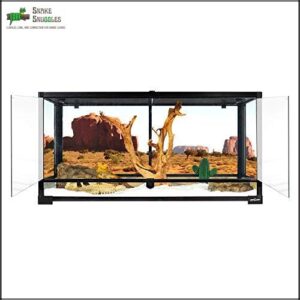
Your snake’s home base deserves careful consideration since they’ll spend their entire life inside those glass walls.
A minimum 40-gallon glass terrarium works for adults, measuring 36" x 18" x 18", though bigger is always better for your slithery friend’s happiness.
You’ll want front-opening doors for easy access, secure locks (corn snakes are escape artists!), and a raised bottom frame to accommodate heating pads underneath the substrate.
Best For: Reptile owners seeking a secure, spacious, and stylish habitat for adult corn snakes, geckos, bearded dragons, and similar species.
- Screen top and door gaps may challenge humidity retention and can lead to minor spills if overfilled.
- Assembly instructions are only in English, which can make setup difficult for non-English speakers.
- Water tank area is too shallow for fish or deep water features.
- Front-opening dual doors with secure locks make access, maintenance, and escape prevention easy.
- Raised bottom and waterproof base support burrowing, substrate heating, and diverse environments.
- Stackable, attractive design fits a range of reptiles and enhances room aesthetics.
2. Coconut Husk Reptile Bedding Blocks
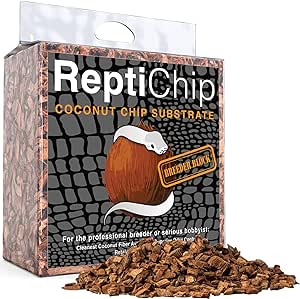
Choosing coconut husk bedding blocks transforms your corn snake’s enclosure into a natural, healthy environment.
You’ll love how these compressed bricks expand to create soft, burrowing-friendly substrate that holds humidity perfectly.
Your snake gets to tunnel and hide naturally while you benefit from excellent odor control and easy cleanup, and the organic material won’t harm your pet if accidentally ingested, and it’s eco-friendly too.
Best For: Reptile owners seeking a safe, natural, and eco-friendly bedding that supports burrowing behavior and maintains humidity, especially for corn snakes and similar species.
- Excellent moisture retention and odor control for healthy, low-maintenance habitats.
- Encourages natural digging and burrowing, promoting reptile mental and physical health.
- 100% organic, biodegradable, compostable, and easy to prepare or clean.
- Can get dusty or messy if allowed to dry out and may require regular misting.
- Large chips may not be ideal for all burrowing reptiles; fine fiber may be better for some.
- Slightly higher cost and bulky storage needs compared to some alternatives.
3. Reptile Terrarium Shale Rock Decor
Why settle for boring bare glass when shale rock decor transforms your terrarium into a natural masterpiece?
You’ll provide essential basking spots, hiding places, and climbing opportunities that mimic your corn snake’s wild habitat.
These non-porous synthetic rocks resist bacteria, clean easily with soap and water, and retain heat from basking lamps for perfect thermoregulation.
Choose pieces with smooth edges to prevent injuries, and secure them properly to avoid shifting accidents, ensuring a safe environment with natural masterpiece design.
Best For: Owners of corn snakes or small reptiles seeking a realistic, easy-to-clean habitat that encourages natural behaviors.
- Mimics natural environments with hiding, basking, and climbing opportunities.
- Non-porous material resists bacteria and simplifies cleaning.
- Retains heat for effective temperature regulation.
- May appear smaller than expected; size check recommended.
- Not suitable for underwater use in fish tanks.
- Initial chemical smell may require thorough cleaning before use.
4. hydroponic seed starting heat mat
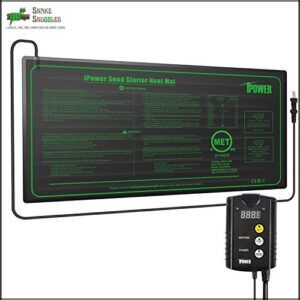
Heat mats designed for hydroponic seed starting work perfectly as reptile heating solutions.
They maintain consistent temperatures between 70-85°F, warming your corn snake’s enclosure by 8-14°F above room temperature.
These waterproof mats distribute heat evenly across the tank bottom, eliminating dangerous cold spots that stress snakes.
They’re energy-efficient, focusing warmth directly where needed rather than heating entire rooms.
Most models include safety certifications and durable construction that withstands continuous operation, making them reliable long-term investments for your snake’s comfort.
They provide a solution that is both effective and reliable.
Best For: Pet owners, indoor gardeners, and reptile keepers who need reliable, adjustable, and energy-efficient temperature control for plants, pets, or propagation setups.
- One-year warranty with limited support, and some units may fail shortly after the coverage period.
- May require plug adapters or add-ons for certain regions, like the UK.
- Heat output may not be sufficient for all tasks, such as some bread proofing setups.
- Even, consistent heating eliminates dangerous cold spots and improves germination, animal comfort, and temperature-sensitive processes.
- Adjustable thermostat and durable waterproof design make it versatile for a range of uses, from snake enclosures to bread proofing.
- Safe, energy-efficient, and certified for continuous operation with flexible storage and easy cleaning.
5. reptile large water dish bowl
When your corn snake needs hydration, you’ll want a water dish that’s both functional and safe.
Choose a large reptile water bowl made from food-grade resin with smooth, non-porous surfaces that prevent bacterial growth.
The dish should allow full-body soaking while featuring safety steps to prevent drowning.
Look for stable construction that won’t tip over when your snake decides it’s bath time.
Best For: Owners of larger corn snakes or other reptiles who need a safe, durable water dish that supports full-body soaking and easy access.
- Heavier weight makes frequent water changes more cumbersome.
- X-Large size may take up more enclosure space than necessary for smaller snakes.
- Some units may have color variations, appearing lighter than pictured.
- Spacious X-Large size allows adult snakes to submerge for hydration and shedding.
- Stable, anti-tip design resists spills and supports natural behaviors.
- Food-grade resin with smooth, non-porous surface simplifies cleaning and helps prevent bacterial growth.
6. Digital Heat Mat Thermostat Controller
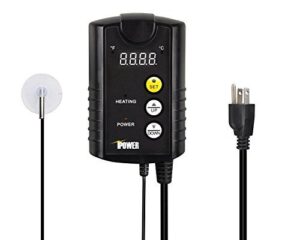
Transform your corn snake’s habitat into a temperature-controlled haven with a digital heat mat thermostat controller.
You’ll maintain precise temperatures between 40°F and 108°F, preventing dangerous overheating that could harm your snake.
The remote sensor probe monitors your enclosure’s temperature in real-time, automatically adjusting heat output to keep conditions stable, while LED indicator lights show you exactly what’s happening.
This essential device eliminates guesswork and guarantees your snake stays healthy and comfortable year-round, with built-in safety features that protect against electrical hazards.
Best For: Corn snake owners and reptile keepers who need safe, reliable, and precise temperature control in their habitats.
- Maintains stable temperatures, reducing stress and health risks for reptiles.
- Easy-to-read digital display with intuitive controls for quick setup.
- Built-in safety features prevent overheating and electrical hazards.
- Accuracy may decrease over time, sometimes requiring replacement.
- Not designed for wet environments; probe and controller must stay dry.
- Occasional reported issues with maintaining exact setpoint temperatures.
Corn Snake Feeding Tips
Feeding your corn snake correctly is vital for their health and growth, but it’s simpler than many new owners expect.
You’ll need to establish a proper schedule and use the right techniques to guarantee your snake thrives without stress or feeding complications, which is crucial for their overall growth.
Feeding Frequency and Schedule
Your snake’s feeding frequency depends entirely on age and size. Young corn snakes need meals every 5-7 days, while adults eat every 10-14 days.
Here’s your complete snake feeding schedule breakdown:
- Hatchlings (8-14 inches): Feed weekly with pinkie mice
- Juveniles (15-30 inches): Feed every 5-7 days with hopper mice
- Adults (3+ feet): Feed every 10-14 days with adult mice or small rats
- Breeding females: Increase meal frequency during breeding season
- Winter months: Reduce feeding frequency as metabolism slows naturally
Understanding a snake’s food schedule needs is essential for its overall health.
Diet and Nutrition Requirements
Your snake’s nutrition hinges on whole prey items like mice and rats. Rodent diets provide complete protein, vitamins, and minerals that commercial snake foods can’t match.
Choose prey that’s 1-1.5 times your snake’s thickest body part. Nutrient needs vary by age – juveniles require more frequent meals for growth while adults need larger portions less often.
Understanding proper corn snake feeding techniques is essential for the health and well-being of your pet.
Handling and Feeding Techniques
When you’ve got your feeding schedule nailed down, proper snake handling techniques become your next priority.
Always wash your hands before and after handling to prevent disease transmission. Use confident, gentle movements when picking up your corn snake – hesitant approaches often stress them more.
Never handle during shedding periods or within 48 hours after feeding, as this disrupts their digestion process and increases handling safety risks.
Corn Snake Handling Guide
You’ll find that proper handling transforms your corn snake from a skittish newcomer into a calm, manageable companion.
Learning the right techniques protects both you and your snake while building the trust that makes ownership rewarding.
Handling Techniques and Safety
How do you safely handle your corn snake without triggering defensive behaviors?
Start with gentle snake handling techniques by approaching from the side, never above.
Support their full body weight using a gentle touch to prevent stress, and keep handling sessions to 10-15 minutes for ideal constrictor care and escape prevention.
These snake safety practices reduce defensive strikes while building trust through proper snake handling tips.
Taming and Trust Building
Building trust with your corn snake takes patience and consistent gentle approaches.
Your snake won’t become cuddly overnight, but regular interaction helps them recognize you’re not a threat.
Here are three proven trust-building methods:
- Start with short sessions – Handle for 5-10 minutes daily, gradually increasing time as your snake shows calming behavior
- Use slow, deliberate movements – Quick motions trigger defensive responses; gentle touch and steady snake handling create positive associations
- Practice trust exercises consistently – Regular bonding methods like letting your snake explore your hands build familiarity and reduce stress responses over time
Understanding snake behavior involves recognizing safe handling techniques to minimize stress and promote a healthy relationship.
Recognizing Stress and Anxiety
Your corn snake’s body language tells you everything about its emotional state.
Watch for stress signs like excessive hiding, refusing food, or rapid breathing – these behavioral changes often indicate anxiety triggers in their environment.
Environmental factors like improper temperatures or loud noises can trigger snake stress, making illness recognition and proper snake health monitoring part of your snake care practices guide, which involves understanding and managing anxiety triggers.
Creating Ideal Environment
Your corn snake’s environment directly impacts its health, behavior, and overall well-being throughout its 20+ year lifespan.
Creating the right balance of lighting, temperature zones, humidity levels, and enrichment features transforms a basic enclosure into a thriving habitat that mimics your snake’s natural preferences, providing a thriving environment.
Lighting and Temperature Gradient
Getting your temperature gradient right makes all the difference between a thriving snake and a stressed one.
You’ll need proper heat sources and lighting options to create the perfect environment for your corn snake’s health.
- Temperature Control: Maintain 85-88°F basking spot, 75-79°F cool side using substrate heaters
- Heat Sources: Use heating pads with thermostats, avoid heat rocks that cause burns
- Gradient Setup: Create 10-15°F difference between warm and cool zones for thermoregulation
- Lighting Requirements: Provide 12-hour light cycle; UVB lighting optional but beneficial for activity
Humidity and Substrate Requirements
Proper humidity control maintains your corn snake’s health through balanced moisture levels between 40-60%.
Use coconut fiber substrate with 2-3 inch depth to naturally regulate humidity within your temperature gradient setup.
This bioactive mix retains moisture better than aspen shavings, preventing shedding problems while supporting your reptile habitat design without creating mold issues.
The substrate’s moisture retention properties are due to its coconut fiber benefits.
Hiding Places and Climbing Structures
Beyond proper humidity control, your snake needs secure hiding places and climbing spots to feel safe in its terrarium.
Rock Caves and Hide Boxes create essential visual barriers, while Tree Branches and Climbing Walls add vertical habitat accessories.
- Position hide boxes on both warm and cool sides of the snake enclosure
- Add sturdy branches or climbing structures for natural behavioral enrichment
- Include rock caves or visual barriers to reduce stress and promote security
Corn Snake Ownership Benefits
You’ll discover that corn snakes offer remarkable value as pets, combining minimal daily care requirements with decades of companionship.
These fascinating reptiles provide unique educational opportunities while maintaining surprisingly low ongoing costs compared to traditional pets.
Low Maintenance and Cost-Effective
You’ll find corn snakes remarkably budget-friendly compared to other pets.
Monthly costs average just $20-50, covering food and bedding.
Their affordable pets require minimal space – a basic 30-gallon setup costs under $200.
Their low-maintenance nature means less time cleaning and fewer vet visits.
Easy care routines make snake ownership costs predictable, perfect for beginner-friendly pet keeping without breaking your budget.
Long Lifespan and Companionship
Your corn snake’s longevity makes it a remarkable pet companion, living 15-25 years with proper corn snake care.
Your 15-25 year commitment means decades of fascinating companionship ahead.
This extended snake lifespan guide demonstrates why pet snake ownership creates lasting animal friendship bonds.
- Snake bonding develops gradually through consistent, gentle handling sessions
- Longevity care requires understanding your pet companions’ changing needs over decades
- Owner responsibilities include maintaining consistent routines throughout their extended lifespan
- Snake companionship offers unique, low-stress interactions unlike traditional pets
Educational and Research Opportunities
Owning corn snakes opens doors to fascinating snake behavior studies and herpetology research.
You’ll contribute to conservation efforts while accessing educational resources that deepen your understanding of reptile care and snake breeding techniques.
These gentle creatures become living laboratories, teaching you about snake habitat requirements and natural behaviors.
Your corn snake ownership tips can help other enthusiasts while supporting broader research studies in the herpetology community and contributing to a better understanding of reptile care.
Frequently Asked Questions (FAQs)
How do you take care of a corn snake?
You’ll need a 30+ gallon glass terrarium with proper heating (85-90°F basking spot), 40-50% humidity, and secure hiding spots. Feed frozen-thawed mice weekly and handle gently but confidently.
Can you keep a corn snake as a pet?
Yes, you can absolutely keep a corn snake as a pet.
They’re beginner-friendly, docile, and low-maintenance compared to other reptiles.
You’ll need proper housing, heating, and feeding schedules, but they make excellent companions.
How to keep a corn snake healthy and happy?
Proper placement and precise preparation prevent problems – you’ll maintain ideal temperature gradients, provide appropriate prey sizes, and guarantee adequate humidity levels for your snake’s wellbeing.
Where can I buy a corn snake?
You can buy corn snakes from reputable breeders, reptile expos, pet stores, or online retailers. Expect to pay $20-40 for juveniles, with captive-bred specimens being healthier than wild-caught ones.
What makes a good corn snake setup?
Like building Rome, you can’t rush creating your snake’s perfect sanctuary.
You’ll need a 36-inch glass terrarium with secure lid, substrate depth of 2-3 inches, hiding spots on both ends, water dish, heating pad, and temperature monitoring equipment.
Can a corn snake be handled?
Corn snakes are naturally docile and handle beautifully when you’re confident and gentle.
Support their body, avoid sudden movements, and they’ll become comfortable with regular interaction.
Skip handling during shedding periods though.
Is it easy to own a corn snake?
Why wouldn’t you want the easiest reptile pet?
Corn snakes are perfect beginner companions—they’re docile, eat weekly, need simple heating, and thrive in basic setups with minimal daily care required.
Do corn snakes get attached to their owners?
Corn snakes don’t form emotional bonds like dogs or cats. They’re solitary creatures who tolerate handling but don’t actively seek affection or recognize individual owners as companions.
What are the cons of owning a corn snake?
You’ll face long-term commitment challenges since they live 15-25 years. Initial setup costs add up quickly, and finding exotic veterinarians can be tricky and expensive when health issues arise.
What permits or licenses are required?
Most states don’t require permits for corn snakes since they’re non-venomous natives.
However, you’ll need to check your local regulations – some cities or counties might’ve restrictions on keeping reptiles as pets.
Conclusion
Ready to start on your corn snake journey?
These corn snake ownership tips will transform you from nervous beginner to confident keeper.
You’ve learned the essentials: proper housing, temperature control, feeding schedules, and gentle handling techniques.
Remember, consistency beats perfection every time.
Your snake doesn’t need fancy equipment—just reliable basics and your attention to detail.
With patience and these proven methods, you’ll enjoy years of rewarding companionship with your scaly friend.
- https://www.thebiodude.com/blogs/snake-caresheets/care-guidelines-for-corn-snakes
- https://amccorona.com/wp-content/uploads/2018/03/ARAV_trifold_cornsnake_4-24.pdf
- https://qualitycage.com/blogs/quality-snake-care/corn-snake-habitat
- https://www.reddit.com/r/cornsnakes/comments/imuqtq/making_comprehensive_corn_snake_care_guide/
- https://www.evolutionreptiles.co.uk/blog/feeding-corn-snakes-preventing-obesity-and-promote-healthy-nutrition/

